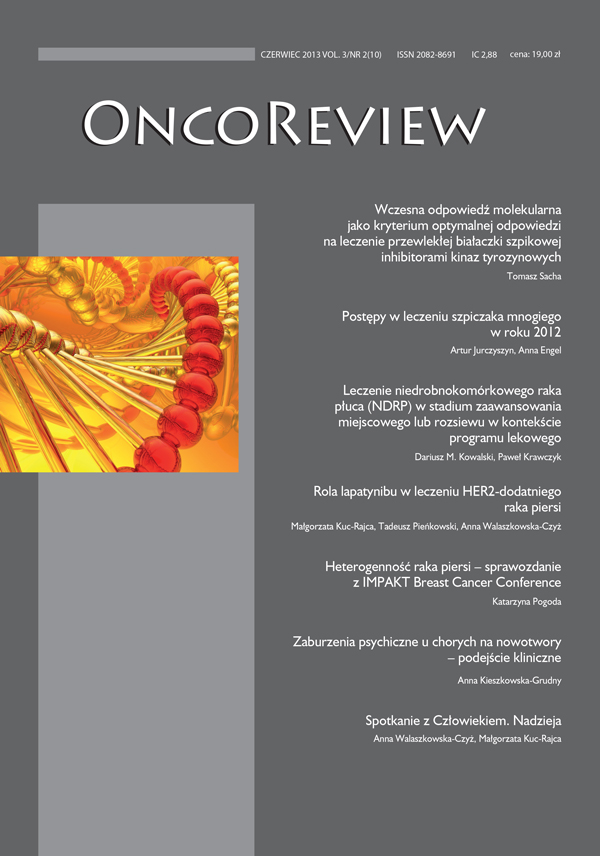Early molecular response as a criterion of optimal response to chronic myeloid leukemia treatment with tyrosine kinase inhibitors Review article
Main Article Content
Abstract
Maximal reduction of leukemic BCR/ABL-positive cells and achievement of persistent deep molecular response with the chance for sustained treatment-free survival in possibly all patients is a current goal of chronic myeloid leukemia therapy. The prognostic factors that could be useful in current clinical practice are investigated since many years now. Fast and deep response to TKI therapy assessed at 3 months from the onset were correlated with improved outcome of further treatment. BCR/ABL level ≤ 10% at 3 months predict improved 3-year MR4.5, PFS, OS, and lower risk of transformation to accelerated phase or blast crisis regardless of the TKI that has been used. CCyR/PCyR achieved at 3 months predict improved 3-year PFS as well. Patients receiving second generation TKIs achieved the BCR/ABL level ≤ 10% at 3 months more frequently with fewer transformations and deaths occurred than patients treated with imatinib. These results support 3-month cutoffs of > 10% BCR/ABL for identifying high-risk patients with worse prognosis. A RQ-PCR result of BCR/ABL > 10% at 3 months should be considered as a treatment failure as indicated in current PALG recommendations for CML therapy.
Downloads
Article Details

This work is licensed under a Creative Commons Attribution-NonCommercial 4.0 International License.
Copyright: © Medical Education sp. z o.o. This is an Open Access article distributed under the terms of the Attribution-NonCommercial 4.0 International (CC BY-NC 4.0). License (https://creativecommons.org/licenses/by-nc/4.0/), allowing third parties to copy and redistribute the material in any medium or format and to remix, transform, and build upon the material, provided the original work is properly cited and states its license.
Address reprint requests to: Medical Education, Marcin Kuźma (marcin.kuzma@mededu.pl)
References
2. Sokal J.E., Cox E.B., Baccarani M. et al.: Prognostic discrimination in ‘good-risk’ chronic granulocytic leukemia. Blood 1984; 63: 789-799.
3. Hasford J., Pfirrmann M., Hehlmann R. et al.: A new prognostic score for survival of patients with chronic myeloid leukemia treated with interferon alpha. J. Natl. Cancer Inst. 1998; 90: 850-858.
4. Hasford J., Baccarani M., Hoffmann V. et al.: Predicting complete cytogeneticresponse and subsequent progression-free survival in 2060 patients with CML on imatinib treatment: the EUTOS score. Blood 2011; 118: 686-692.
5. Baccarani M., Rosti G., Castagnetti F.: Comparison of imatinib 400 mg and 800 mg daily in the front-line treatment of high-risk, Philadelphia-positive chronic myeloid leukemia: a European LeukemiaNet Study. Blood 2009; 113: 4497-504.
6. Hughes T.P., Hochhaus A., Branford S.: Long-term prognostic significance of early molecular response to imatinib in newly diagnosed chronic myeloid leukemia: an analysis from the International Randomized Study of Interferon and STI571 (IRIS). Blood 2010; 116(19): 3758-65.
7. Deininger M., O’Brien S.G., Guilhot F. et al.: International randomized study of interferon vs STI571 (IRIS) 8 year follow-up: sustained survival and low risk for progression or events in patients with newly diagnosed chronic myeloid leukemia in chronic phase (CML-CP) treated with imatinib. Blood 2009; 114(ASH Annual Meeting Abstract): 1126.
8. Hehlmann R., Lauseker M., Jung-Munkwitz S. et al.: Tolerability-adapted imatinib 800 mg/d versus 400 mg/d versus 400 mg/d plus interferon-α in newly diagnosed chronic myeloid leukemia. J. Clin. Oncol. 2011; 29(12): 1634-42.
9. Jabbour E., Kantarjian H., O’Brien S. et al.: Predictive factors for outcome and response in patients treated with second-generation tyrosine kinase inhibitors for chronic myeloid leukemia in chronic phase after imatinib failure. Blood 2011; 117: 1822-1827.
10. Hughes T., Branford S.: Molecular monitoring of BCR-ABL as a guide to clinical management in chronic myeloid leukaemia. Blood Rev. 2006; 20(1): 29-41.
11. Marin D., Hedgley C., Clark R.E. et al.: Predictive value of early molecular response in patients with chronic myeloid leukemia treated with first-line dasatinib J. Clin. Oncol. 2012; 30(3): 232-238.
12. Hanfstein B., Mueller M.C., Hehlmann R. et al.: Early molecular and cytogenetic response is predictive for long-term progression-free and overall survival in chronic myeloid leukemia (CML) Leukemia 2012; 26: 2096-2102.
13. Marin D., Hedgley C., Clark R.E. et al.: Brief report. Predictive value of early molecular response in patients with chronic myeloid leukemia treated with first-line dasatinib. Blood 2012; 120: 291-294.
14. Saglio G., Kantarjian H.M., Shah N. et al.: Early Response (Molecular and Cytogenetic) and Long-term Outcomes in Newly Diagnosed Chronic Myeloid Leukemia in Chronic Phase (CML-CP): Exploratory Analysis of DASISION 3-Year Data. Blood. 2012; 120(21): [streszczenie 1675].
15. Hochhaus A., Boque C., Garelik M.B. et al.: Molecular response kinetics and bcr-abl reductions in Patients with newly diagnosed chronic myeloid leukemia in Chronic phase (cml-cp) receiving dasatinib vs imatinib: DASISION 3-year follow-up. Haematologica 2012; 97(s1): abstract 0192.
16. Hochhaus A., Hughes T.P., Saglio G. et al.: Outcome of Patients with Chronic Myeloid Leukemia in Chronic Phase (CML-CP) Based On Early Molecular Response and Factors Associated with Early Response: 4-Year Follow-up Data From Enestnd (Evaluating Nilotinib Efficacy and Safety in Clinical Trials Newly Diagnosed Patients). Blood 2012; 120(21): [streszczenie 0167].
17. Sacha T., Lewandowski K., Hellmann A. et al.: Rekomendacje PALG dotyczące diagnostyki i leczenia przewlekłej białaczki szpikowej w 2013 r. Acta Haematol. Pol. 2013 (w druku).

